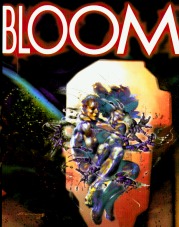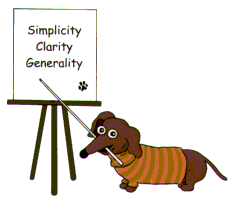

These are the reviews from the Winter of 1998-99. For newer reviews, go back to the main book page.
 Ever since nanotechnology was proposed back in the late 1970s (check this?),
science fiction writers have penned cautionary tales about the
capacity of self-reproducing nanomachines to run out of control.
Bloom takes this theme to a wrenching extreme: when
the book opens, aggressive biomachines have taken over the
entire volume of the inner solar system. The main character,
a part-time journalist, volunteers for a dangerous
research trip down
from humanity's refuge in the outer system into the depths
of machine space. However, the machines are more than they
seem; the mystery develops over the course of the trip sunward,
along with a fascinating visit to a city in the asteroid belt,
an introduction to scientific study of cellular automata,
and a stunning betrayal.
Ever since nanotechnology was proposed back in the late 1970s (check this?),
science fiction writers have penned cautionary tales about the
capacity of self-reproducing nanomachines to run out of control.
Bloom takes this theme to a wrenching extreme: when
the book opens, aggressive biomachines have taken over the
entire volume of the inner solar system. The main character,
a part-time journalist, volunteers for a dangerous
research trip down
from humanity's refuge in the outer system into the depths
of machine space. However, the machines are more than they
seem; the mystery develops over the course of the trip sunward,
along with a fascinating visit to a city in the asteroid belt,
an introduction to scientific study of cellular automata,
and a stunning betrayal.
There have been a few other novels with some of the same thematic elements as Bloom, most notably Greg Bear's classic Blood Music. While Wil McCarthy has not quite reached Bear's level, he has still given us a rattling good story. If you like a technical and thoughtful adventure story, then Bloom is a great choice.
Conclusion: Highly Recommended
Patterns in the Sand is a member of the Perseus Book Group's new "Frontier of Science" series. Each entry in the series provides a survey of emerging areas of science or interdisciplinary endeavors, with greater depth than one might find in mass-market periodicals but more accessible than the scientific journals.
One of the most effective chapters in the book treats the topic of connections. The authors explain several examples of how connections arise in society, games, and other contexts. The chapter concludes with a very well-written discussion of connectivity avalanching, a tricky concept from mathematical graph theory that has profound implications for ecology and sociology.
There have been other books in the past few years that cover a mix of topics similar to that of Patterns in the Sand, most notably Murray Gell-Mann's The Quark and the Jaguar. These two books do share a few features, but Professors Bossomaier and Green emphasize computational aspects of modeling complexity, in contrast to Dr. Gell-Mann's more physics-oriented treatment.
Despite the breadth of its subject, Patterns in the Sand communicates the enthusiasm and expertise of its two authors very well.
Conclusion: Recommended
 The book covers a wide variety of topics, each in only
moderate detail.
The book covers a wide variety of topics, each in only
moderate detail.
The title of the book, The Pattern on the Stone refers to the practice of creating micro-electronic circuits by photo-chemical lithography on silicon wafers. The book includes several funny nostalgic stories about the history of computing; the author is unable to resist the tempatation to gloat just a little about some of his successful technological predictions.
The book is quite short, less than 160 pages. If anything, the book's brevity is its biggest failing: a few of the topics are treated so shallowly as to be almost useless. For example, the treatment of automata covers only a few pages, and doesn't even mention the equivalencies of formal automata and grammars. The coverage of parallel computing, a field in which Dr. Hillis was an important pioneer, is fascinating but much too short.
Conclusion: Recommended
Prior to reading this book, I was only slightly familiar with the postmodernist views; regarding the espouser of its principles are luddites or, at best, fringe scholars. I've since learned differently - postmodernists are respected scholars and academics, promoting superficially plausible social doctrine to the detriment of genuine science and science criticism. The controversy surrounding Alan Sokal's parody essay in the postmodernist journal Social Text exposed some general readers to the problem, but the mass media focused on the controversy of Sokal's deception, rather than on the peculiarities of the field he successfully mocked. Subtitled Exposing Postmodernist Myths about Science, this book details the principles and beliefs of postmodernism, and shreds them. The most fundamental belief, sometimes called the equivalence postulate, is that all beliefs are relative and of equal value; in the postmodernist view, scientific beliefs hard-won by experiment and mathmatics are worth no more than social opinions agreed upon by popular culture.
The book contains eighteen essays, all of them very well written and convincingly argued. The essays are grouped into five sections: the strange world of post-modernist science studies; myths, metaphors and misreadings; interests, ideology, and the construction of experiments; art, nature, and the rise of experimental method; and civilian casualties of postmodern perspectives on science. The editor of A House Built on Sand is Dr. Noretta Koertge, a professor at Indiana University, trained in both history and chemisty. In addition to selecting the authors to contribute to the book, she also provides a straightforward introduction for each section, with some background for the authors and their point of view. The list below gives a capsule summary of a few of my personal favorites among the essays.
This book is not written for casual readers. The authors of the essays attempt to be entertaining at times, but their goals are not to amuse but to instruct. A good grounding in the fundamentals of science and basics of rhetoric are essential for understanding the dense academic prose that fills the book's 300 pages. A House Built on Sand was one of the most challenging books I've picked up in years, but it was worth the effort.
Conclusion: Conditionally Recommended
Conclusion: Not Recommended
 The book is modest in length, only about 240 pages. This may seem
peculiar to some 1990s programmers, accustomed to 1000-page tomes for
each new topic or hot technology. When you read it, though, the
length feels right. This is not a reference manual, it lays no claim
to authoritative generality. Each of the nine chapters offers a
brief but insightful look at a particular topic: algorithms & data
structures, notation, interfaces, testing, and more.
The book is modest in length, only about 240 pages. This may seem
peculiar to some 1990s programmers, accustomed to 1000-page tomes for
each new topic or hot technology. When you read it, though, the
length feels right. This is not a reference manual, it lays no claim
to authoritative generality. Each of the nine chapters offers a
brief but insightful look at a particular topic: algorithms & data
structures, notation, interfaces, testing, and more.
The examples that illustrate each concept are carefully crafted and reasonable in size. Only a few longer than a full page. Most of the examples consist of C or C++ code, nearly all of the rest are Java code. One of the best chapters in the book presents a clever text generator, and then explains simple implementations in C, Java, C++, Awk, and Perl.
Perhaps it is beside the point, but the book is typeset with simple, clear structure and layout, making it easy and comfortable to read. The authors and the publisher have thankfully declined to take advantage of the distracting sidebars, loud icons, darkened boxes, and flowery fonts that characterize so many recent computer books.
Every programmer, beginner to veteran, will be able to learn something from Kernighan and Pike. Whatever language you employ in your daily toil, the principles and pointers in The Practice of Programming will surely be useful.
Conclusion: Highly recommended for all programmers
All reviews (c) 1998-99, Neal Ziring. Reviews may be reproduced in whole or
in part as long as authorship credit is preserved.
[Ziring
MicroWeb Home] [Neal
Ziring] [Julie
Ziring]
[Ziring Guestbook]
This page written by Neal Ziring, last modified 4/4/99.